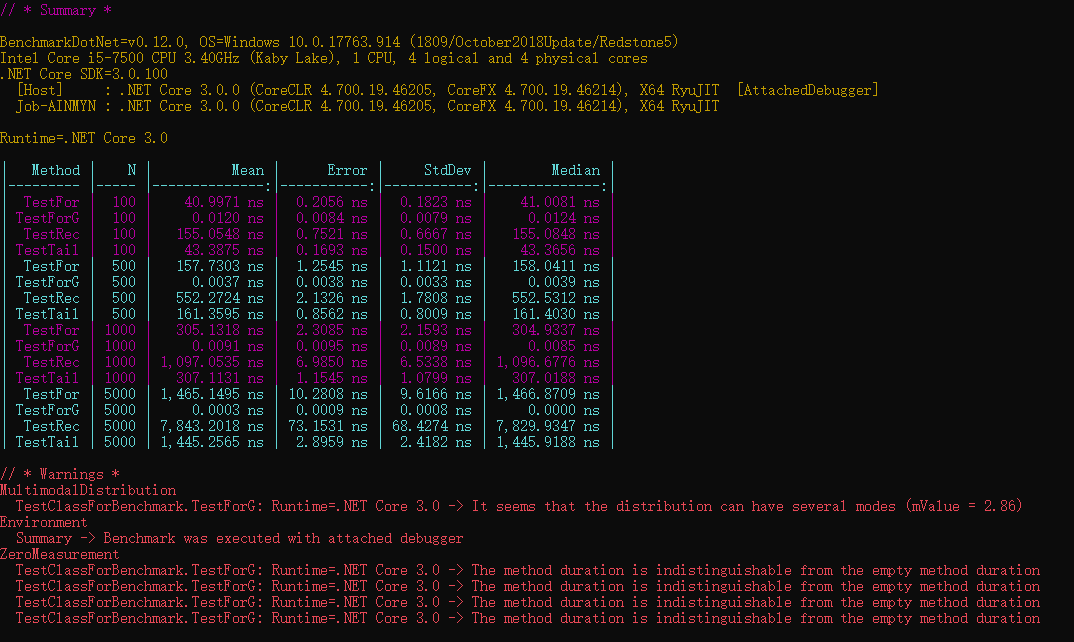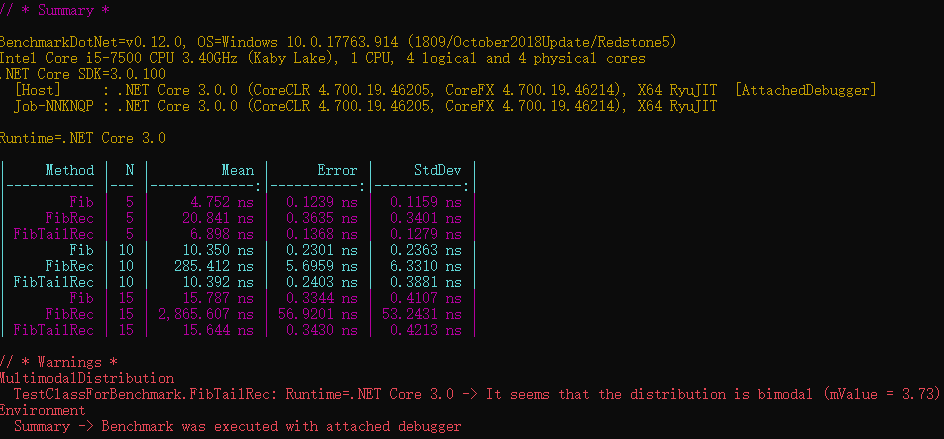生活中,如果1+2+3+4.....+100,大家基本上都會用等差數列計算,如果有人從1開始加,不是傻就是白X,那麼程式中呢,是不是也是這樣。今天無意中看到了尾遞歸,以前也寫過,但是不知道這個專業名詞,今天寫一下對比下性能問題。 今天主要是看到了尾遞歸,所以聯想到了這些,寫下這篇文章,其中也把Ben ...
生活中,如果1+2+3+4.....+100,大家基本上都會用等差數列計算,如果有人從1開始加,不是傻就是白X,那麼程式中呢,是不是也是這樣。今天無意中看到了尾遞歸,以前也寫過,但是不知道這個專業名詞,今天寫一下對比下性能問題。
今天主要是看到了尾遞歸,所以聯想到了這些,寫下這篇文章,其中也把Benchmark (Nuget上的BenchmarkDotNet)的基準測試用了下,感覺比較好用,贊。Benchmark 需要在release下運行。
原則上所有的遞歸操作,都可以寫成迴圈操作。尾遞歸是指,在函數返回的時候,調用自身本身,並且return語句不能包含表達式。這樣編譯器或者解釋器就可以把尾遞歸做優化,試運行速度更快。
測試類

public class TestClass { /// <summary> /// for迴圈 /// </summary> /// <param name="n"></param> /// <param name="counter"></param> /// <returns></returns> public int TestFor(int n) { int s = 1; for (int i = 2; i < n + 1; i++) { s = s + i; } return s; } /// <summary> /// 等差數列 /// </summary> /// <param name="n"></param> /// <param name="counter"></param> /// <returns></returns> public int TestForG(int n) { int s = (1 + n) * n / 2; return s; } /// <summary> /// 遞歸 /// </summary> /// <param name="n"></param> /// <param name="counter"></param> /// <returns></returns> public int TestRec(int n) { if (n == 1) return 1; return n + TestRec(n - 1); } /// <summary> /// 尾遞歸 /// </summary> /// <param name="n"></param> /// <param name="counter"></param> /// <returns></returns> public int TestTail(int n) { return TestTail(1, n); } public int TestTail(int sum, int n) { if (n == 1) return sum; sum = sum + n; return TestTail(sum, n - 1); } }View Code
基準測試

[SimpleJob(RuntimeMoniker.NetCoreApp30)] [RPlotExporter] public class TestClassForBenchmark { private readonly TestClass testClass = new TestClass(); [Params(100,500,1000,5000)] public int N; [Benchmark] public void TestFor() { testClass.TestFor(N); } [Benchmark] public void TestForG() { testClass.TestForG(N); } [Benchmark] public void TestRec() { testClass.TestRec(N); } [Benchmark] public void TestTail() { testClass.TestTail(N); } }View Code
Main程式調用
BenchmarkRunner.Run<TestClassForBenchmark>();
結果

用Benchmark的基準測試發現,運行時間:等差 < for < 尾遞歸(接近for) < 遞歸,for的運行速度比遞歸快,但是遞歸結構比較清晰,容易理解。
發現TestForG有點問題,接下來自己簡單測試
實際用Stopwatch測試

TestClass testClass = new TestClass(); Stopwatch stopSwitch = new Stopwatch(); int n = 5000; stopSwitch.Start(); int sum = testClass.TestFor(n); stopSwitch.Stop(); Console.WriteLine($"結果:{sum},TestFor時間:{stopSwitch.ElapsedTicks}"); stopSwitch.Start(); sum = testClass.TestForG(n); stopSwitch.Stop(); Console.WriteLine($"結果:{sum},TestForG時間:{stopSwitch.ElapsedTicks}"); stopSwitch.Restart(); sum = testClass.TestRec(n); stopSwitch.Stop(); Console.WriteLine($"結果:{sum},TestRec時間:{stopSwitch.ElapsedTicks}"); stopSwitch.Restart(); sum = testClass.TestTail(n); stopSwitch.Stop(); Console.WriteLine($"結果:{sum},TestTail時間:{stopSwitch.ElapsedTicks}");View Code
Stopwatch測試結果
1. 10次 結果:55,TestFor時間:2024 結果:55,TestForG時間:3799 結果:55,TestRec時間:1603 結果:55,TestTail時間:2371 2. 100 結果:5050,TestFor時間:1704 結果:5050,TestForG時間:2708 結果:5050,TestRec時間:1069 結果:5050,TestTail時間:1401 3. 500 結果:125250,TestFor時間:1794 結果:125250,TestForG時間:3096 結果:125250,TestRec時間:9398 結果:125250,TestTail時間:2332 4. 1000 結果:500500,TestFor時間:2080 結果:500500,TestForG時間:4147 結果:500500,TestRec時間:2003 結果:500500,TestTail時間:2540 5. 5000 結果:12502500,TestFor時間:1428 結果:12502500,TestForG時間:3982 結果:12502500,TestRec時間:6815 結果:12502500,TestTail時間:2799
結論
1. for的運行速度比遞歸快,但是遞歸結構比較清晰,容易理解。
2. 等差計算不一定比for迴圈快
斐波那契數列對比
/// <summary> /// 迴圈實現 counter:運行次數 /// </summary> public long Fib(int n, ref int counter) { if (n < 1) return 0; long a = 1, b = 1; long temp; for (int i = 3; i <= n; i++) { counter++; temp = a; a = b; b = temp + b; } return b; } /// <summary> /// 遞歸實現 /// </summary> public long FibRec(int n, ref int counter) { counter++; if (n < 1) return 0; if (n < 3) return 1; return FibRec(n - 1, ref counter) + FibRec(n - 2, ref counter); } /// <summary> /// 尾遞歸實現 /// </summary> public long FibTailRec(int n, ref int counter) { if (n < 1) return 0; if (n < 3) return 1; return FibRec(1, 1, n, ref counter); } public long FibRec(long last, long prev, int n, ref int counter) { counter++; long temp = last + prev; if (n == 3) return temp; last = prev; prev = temp; return FibRec(last, prev, n - 1, ref counter); }
效果

counter是運行的次數,斐波那契數列直接用遞歸,n=100都直接堆棧溢出。遞歸用的好了,思路清晰,用的不好的話,數據稍微大點就是深深的坑。用遞歸儘量優化為尾遞歸,也就是返回的時候調用自身,不要有表達式。




